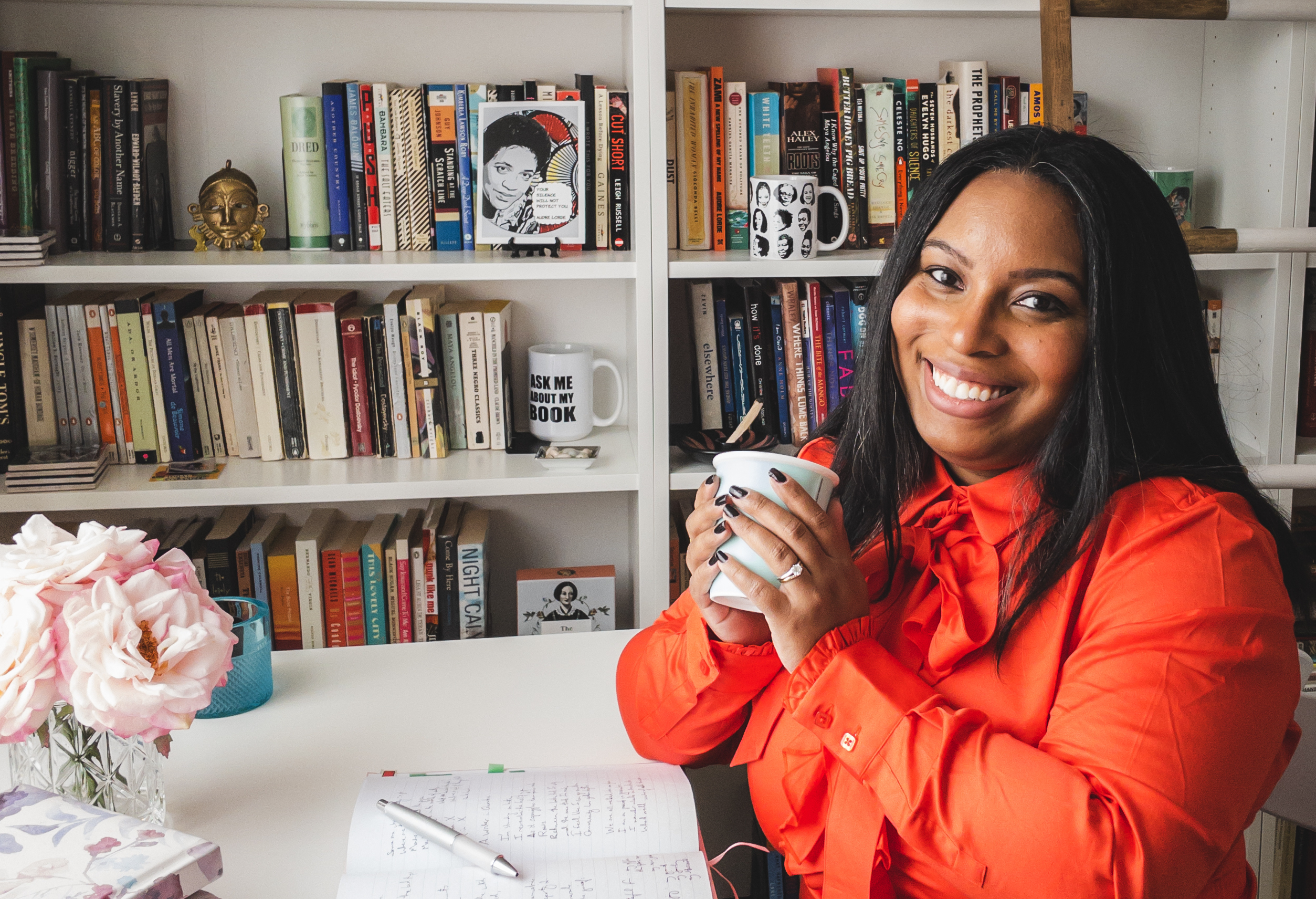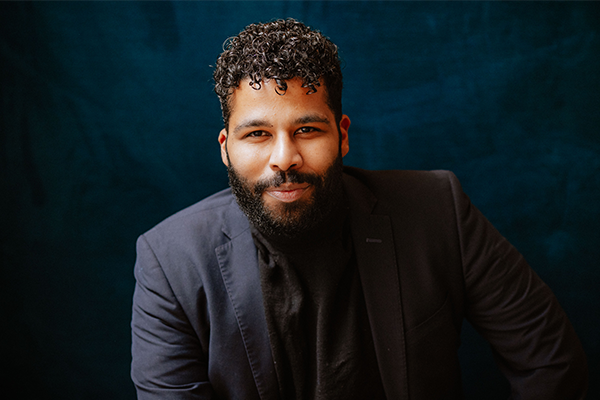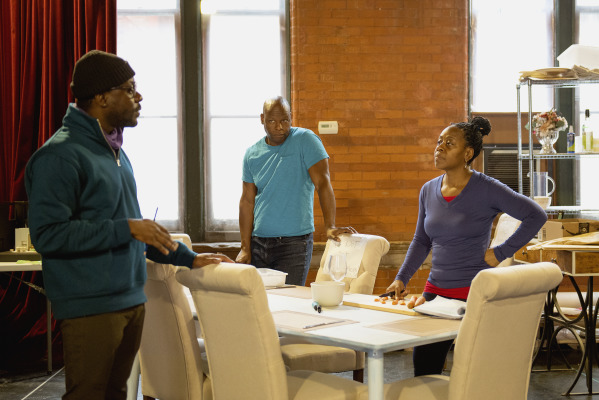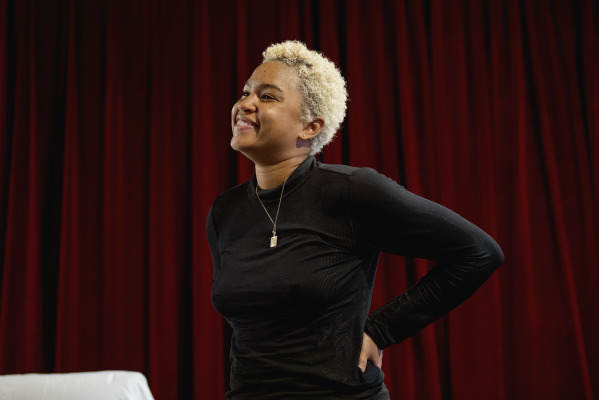Fairview Audience Resources
Thank you for attending Fairview. In an effort to enrich any lingering curiosities from your experience, we have collected the following reflections and resources.
Below you will find an interview between Jesse Green and Salamishah Tillet of the New York Times, in which they discuss their first impressions of the show; links to Jackie Sibblies Drury talking about her intentions of the work; and some definitions of concepts that come up in the show.
Tawiah is Changing the Landscape of Canadian Theatre One Powerhouse Show At A Time
By: Fiona Raye Clarke
Tawiah M’Carthy is a powerhouse theatre practitioner, playwright, and director whose latest work is directing Jackie Sibblies Drury’s Pulitzer Prize-winning play, Fairview, which is playing in a co-production between Obsidian Theatre and Canadian Stage March 6 to 23rd.
In Fairview, an upper-middle-class, African American family prepares a birthday dinner for Grandma, but everything is not what it seems in this radical examination of race, power, and surveillance.
Tawiah and I discussed his career, Fairview, and his work as a Ghanaian-born theatre creator operating at the intersections of his Ghanaian and Canadian identity to change what theatre can be.
Fiona Raye Clarke (FRC): How were you able to carve a path for yourself within Canadian theatre?
Tawiah M’Carthy (TM): It was challenging. When I got out of school, I had an accent and I’m Black, so I wasn't getting jobs. During that time, I often thought of giving up since I couldn't make a living. My breakthrough was deciding to create work for myself. If there was no character I could play, then I was going to start creating those stories. That was the beginning of The Kente Cloth, Obaaberima, Black Boys, and Maanomaa, which was me actively creating space for myself. Fortunately, I was surrounded by people and mentors who believed in my capabilities.
Since I live within the intersection of being Ghanaian and Canadian, I bring my culture and all of who I am to the work. For example, my first show, The Kente Cloth, has a character speaking Twi, and Obaaberima the very title of the play, most people couldn't even pronounce. Most Canadians live in a place of intersection and are part of multiple cultures. So, to tell a story that only sits within one culture is not actually true of Canadian identity. I always think: how do we actually put into practice creating work that everyone sees themselves in? That means shifting from what we know and expanding to make room for all these others.
FRC: To say too much about the play would be to spoil the experience, but how has your body of work prepared you for tackling Fairview?
TM: I really don't think anything quite prepared me for this. Because the play is a conversation around race - that much I can say – and around the consumption of art and theatre in relation to race, I think growing up in Ghana and being here, as an African Black body, in Canada, enables me to hold that conversation. Being othered and someone who's always going through the challenges of what it means to be Black in Canada, my experience of navigating my racial identity within the industry, the community, within this country, affords me space to really investigate what’s happening within the play. Also, tackling shows like Death and the King’s Horseman at Stratford was in some way a necessary step towards Fairview.
Part of my training as a director was being mentored by Philip Akin through Obsidian’s mentorship program. I was also mentored by Brendan Healy, here at Canadian Stage and was part of their RBC Emerging Artist Program as a director. So having the opportunity to come here and direct a show around this particular conversation with these two organizations feels like a continuation of a circle - working with them is such a gift.
FRC: Did you adapt the play in any way to the Canadian context?
TM: I'm doing the play as is. It’s still a Black American family. Most Canadians think that America is a racist country, and not so much Canada. But we buy into everything that Americans do; we follow the star system, consume their art, to some extent, even more than our own. American popular culture is something that we chase after. There's something around us mimicking that culture, that is quite relevant to this production, and relates to African Canadians and how we talk about race.
Without giving too much away, there’s a particular connection to Black sitcoms. Growing up in Ghana, I watched Black sitcoms, which also shaped my perspective. So, watching a story about an upper-middle-class, Black family is something we were all introduced to through American pop culture. It was important for me to hold on to that interpretation because I think that's where the conversation starts - how we consume Black art, Black theatre, and Black stories. Certain stories are intended to move in a certain way, and we need to hold true to what the playwright is doing. There was intentionality in the way Jackie has written the story and I wanted to hold on to that integrity because I strongly believe in what she’s doing with the play. I think those who witness it will know that there's something quite intentional around the conversation that's happening.
FRC: How did you take your cast through the process of mounting Fairview and how did you try to keep them safe?
TM: I think it's always important to create an ensemble before you actually go to the work. In my practice, we spend time going through the story, the action of the play, and knowing our role in actually achieving that. So that it becomes less about the actors and their feelings about the work, and more about what the story is doing. We spent some time getting to know each other as an ensemble. Especially with this piece, it's important to make sure that the artists, including the designers, and those who are talking about the play outside of the rehearsal room, are all on the same page about what the action is. It's easy to create a divide, particularly with a story like this. We created a community agreement as to how we were to work and have regular check-ins at the start and end of the day. As an ensemble we share whatever we're struggling with, so that we can find ways to navigate together. We brought in an active listener, whom the actors can talk to about the personal challenge of crafting their character and who will remind them of the self-care that's needed to be able to go into the work on a daily basis. This is so that my focus as a director can stay on the work to hold the space for everyone else in the room.
FRC: What’s exciting about bringing Fairview to Canadian audiences for the first time?
TM: I think the style of theatre itself is exciting to me. There's a deliberate, chaotic conversation within the play that invites the full commitment and attention of the audience. I like to create experiences, so it's a joy to have my audience be an active part of the story and the way the show engages or challenges the audience is exciting. If you're coming to the show just to be a spectator or be entertained, you're going to find yourself a bit more immersed in the show than you were planning on.
I also enjoy that the play is full of surprises. The turns and curves of the story; the things that happen are unexpected. Since Canadians are not big fans of conflict, I'm excited to see how a Canadian audience interacts with the discomfort in the play. I hope it brings up an active consideration of our own understanding of race in Canada.
FRC: What would you tell someone going to see the show?
TM: Every one of us is one of the characters on the stage. Be patient; be kind to yourself. There is a level of vulnerability that's required to interact with the play, so allow yourself the space for that. This play requires all your senses, for you to listen actively and watch attentively what occurs. It's an invitation into a conversation. Be ready to be part of that.
FRC: You also have Maanomaa, My Brother coming up in April. How did that piece come about?
TM: Maanomaa is a piece that myself and my colleague and collective partner, Brad Cook, started working on in 2016. We did our first workshop presentation and then, took a break from it to pursue our professional careers and learn more. For me, it's a combination of my practice as an artist, and what myself and Brad envision the possibility of theatre to be. The show combines movements and texts, employs different languages, and is actually set in Ghana.
It's a story about two childhood friends who grew up in Ghana, one is Black and the other is white. They have a life-changing event that separates them, and years later another event brings them together. They have to deal with things of the past that they couldn't deal with as kids. It's also a conversation around my relationship with Ghana, my family, friends, and about growing from a young boy into a man, especially here in Canada, and what that means.
*This interview was revised for clarification.

Fiona Raye Clarke is an award-winning Trinidadian-Canadian writer and community-engaged artist. Her writing has appeared online and in print in The Puritan Town Crier, the Room Magazine blog, and Quill & Quire, among others. Productions and staged readings of her plays have been produced by b current’s rock.paper.sistahz festival, InspiraTO, and elsewhere. She is the Artistic Director of the Black youth oral history theatre project, INTERGENERACIAL and her co-created kids’ TV animated series, Mixed Up, recently had its pilot released on CBCKids.ca.
Instagram and Twitter: @fionarclarke
With so many black playwrights writing so passionately about these questions right now, the “Fairview” challenge was too important to pass up. Salamishah Tillet, a professor of African-American studies and creative writing at Rutgers University-Newark and a frequent contributor to The New York Times, and Jesse Green, the co-chief theater critic for The Times, sat down for a conversation.
JESSE GREEN Let’s start with our experiences at the end of “Fairview”: mine as a self-identified white man —
SALAMISHAH TILLET And mine as a self-proclaimed black woman. I guess we have to talk about the ending.
GREEN How did it go down for you in the audience?
TILLET Once Keisha invited the white audience members to come onstage, I was shocked and I wondered “Why are they going up there?” I assume that the play thought it was creating a safe space for the people of color who remained in the audience.
GREEN My audience seemed to be about 90 percent white.
TILLET Mine as well.
GREEN I was originally afraid to go onstage because I just don’t feel comfortable with audience participation and theater that picks me out to dance or do things. But that’s not what happened. Once onstage, we were left to our own devices, ignored. And the lights were so bright on us that I couldn’t see what was going on in the audience. Nor could I hear Keisha very well as she spoke to those who remained seated. That’s when I realized that far from being picked out as an individual, I was being treated as part of a group. A white group. Ah, I thought: Not everything is about us. I realized that was the point.
Full interview can be found here
Jackie Sibblies Drury is a Brooklyn-based playwright. Her critically acclaimed play Fairview premiered in summer 2018 at Soho Rep. Other plays include We Are Proud to Present a Presentation About the Herero of Namibia, Formerly Known as South West Africa, From the German Sudwestafrika, Between the Years 1884-1915, Really, and Social Creatures.
Jackie Sibblies Drury work has become known for her tackling of modern social inequities, such as privilege and race, that are presented in brave and sometimes alarming ways to disrupt the comforts of theatre conventions. Her plays have a tendency of starting off intentionally vague or incorporating absurdist elements to slowly brew into bold portrayals of the truly ugly side of today’s society.
Here is an interview she did with Liz Appel for Vogue Magazine.
Did you have an idea of what you wanted white audience members to feel at the end of the play?
I didn’t think of shame, or lecturing, or scolding, or anything like that. In conversations that I’ve been having with people, white guilt is a real thing. People feel so overwhelmed or shut down by identity politics in general. Some white people can get defeatist really quickly. It was a hopeful gesture, at least initially. Even in this small way, in this fictional space, this moment offers something the white audience member can do. It’s an active, positive, uncomfortable but possible thing.
Did you have a sense of how you wanted people of color to feel at that moment?
We knew that we didn’t want people of color to feel on display. We were all excited to try to have a theater space—which is always coded as a white space, unless it’s a very specific kind of theater—shift for the benefit of people of color. Normally, it’s the reverse; people of color have to shift to fit into the room. I thought it could be cathartic to create a space in which some audience members make themselves uncomfortable in order to try to make people of color feel more comfortable.
Full interview can be found here
“I think for me a lot of it is based in my own experience of seeing play and being...a very deferential person and nervous person. When I am personally made uncomfortable in a situation, I want to make myself feel better and make the other person, who made me uncomfortable feel better almost immediately by making a joke, laughing the situation off, being ironic about it. And I wanted to free the audience and the performers of that need to make everything ok, because it’s just not ok. Allowing that was really important to me.” Jackie Sibblies Drury, HowlRound Theatre Commons Interview
White Gaze
Definition: White Gaze is the assumption that a work is created for white readers or audiences.
How it Came About
Acclaimed novelist Toni Morrison popularized the term and has spent her career rejecting the White Gaze in her works. In a 1998 interview with Charlie Rose she said, “Can you imagine writing a novel not centered around race? I remember a review of Sula in which the reviewer said this is all well and good but one day she, meaning me, will have to face up to the real responsibility and get mature and write about the real confrontation for black people, which is white people. As though our lives have no meaning and no depth without the white gaze. And I have spent my entire writing life trying to make sure that the white gaze was not the dominant one in any of my books.”
White Gaze is a byproduct of White Supremacy. Many of the institutions that have the ability to advance the careers of artist of colour were built by white people and have spent their histories tailoring to white audiences. To go against the White Gaze can be misconstrued to be risky, inaccessible, and uninteresting to these institutions, but to uphold it means to forsake the very communities these artists represent.
Impact
This impacts many artists of colour as they create works in the North American arts sector. Artists are often left wondering:
- Whether they are unable to create work without centering or addressing race
- Whether works that rejects the White Gaze will be of interest or profitable
- If they should avoid writing about experiences that could be twisted into harmful stereotypes of their own cultures
- If they are self-policing their content and the language through which it’s delivered to make their work palatable for white audiences
- Being self-conscious or even fearful of how white audiences will react to their work and the power that those reactions can have
- If it is their job to carry the emotional labour of White Fragility
"What happens to the writerly imagination of a black author who is at some level always conscious of representing one's race to, or in spite of, a race of readers that understands itself to be 'universal' or race-free?" Toni Morrison, Playing in the Dark
“A lot of the non-traditional work that’s being made by people of color is confronting race in a way that centers whiteness. Even Fairview. This play couldn’t happen for an audience that was entirely people of color. It needs to have white people to function. So even this play, that is trying to decenter whiteness, actually centers whiteness in and of itself.” Jackie Sibblies Drury, Vogue
Additional links and resources on the White Gaze
Toni Morrison rejected the “White gaze” - The Caribbean Camera
Understanding The White Gaze And How It Impacts Your Workplace (forbes.com)
Writing Past The White Gaze As A Black Author : Code Switch : NPR
Morrison speaks on evil, language and 'the white gaze' | Cornell Chronicle
The White Gaze – Is it Fear or Racism? - Guardian Liberty Voice (guardianlv.com)
History of Black Performance for White Audiences
The history of black performance for white audience dates back to colonialism and the slave trade and have taken place internationally. This includes both consensual and nonconsensual performing across theatre, dance, music, comedy, and simple existing. Some of these performances include:
Minstrel shows
Minstrel shows were vaudevillian variety shows that featured song, dance, comedy routines, and most notably, white performers in blackface that mocked and stereotyped black people. They developed and peaking in popularity during the 19th century, when Black people were not allowed to participate in theatre alongside their white counterparts, either as performers or patrons. Some black performers who wanted to join in the minstrel shows also began painting their faces, since the only way white audiences would “tolerate” black performers was if they were unknowingly watching them, thinking it was a white person in blackface. Around 1840, black people were allowed to join in minstrel shows, though the performances were no longer as popular.
Human Zoos
From the early days of colonization until 1958, we saw the uncomfortable emergence of Human Zoos, establishments that held people of colour in partially or fully caged areas for the viewing and entertainment of white people around Europe and North America. The people in these zoos were treated exactly like animals, being given minimal clothing, space, and food, and many people died from these conditions. These zoos directly impacted societal perception on the commodification of black bodies, shaming and misinformation around cultural practices, and false theories on evolution and eugenics.
Mainstream Recognition
Throughout the first half of the 20th century, black performers started funding their own artistic spaces which led to the founding and significant impact of drag performance, tap dancing, swing dancing, jazz, disco, amongst many others. These styles and genres began to grow in popularity and made their way to white audiences. Still, segregating and racist tactics put a cap on the success of black artists which led to many works being stolen and appropriated by white industry members. Many white audiences were only comfortable seeing black performers in certain spaces, genres, and archetypes. Larger roles for black people could often be categorized as:
- Mammy: a large, non-sexualized, older, matronly woman. Uneducated, content, subservient.
- Matriarch: old grandmotherly figure, who offers wisdom, caretaking, and stability.
- Sapphire: a younger, independent woman known to drive away men. Cold, outspoken, angry.
- Jezebel: overly sexualized, young and beautiful woman. Thought of as manipulative and immoral.
- Brute: a nonsensically violent and angry man. Ugly, rude, troublesome, menacing.
- Mandingo: almost animalistically sexual, morally corrupt, and dangerous man that preys on white women
- Uncle Tom: an aloof, loyal, serving man. Usually older, harmless, and thoughtless
- Magical Negro: a supporting character who helps the white lead through some divine abilities. They often have no desires of their own
Although these archetypes may not be as obvious today, many black performers are still slotted into various characters that lack their own intentions and support the narrative of other white characters such as: the best friend, the help (assistant/cleaner), the villain, or the comedic relief.
Additional Links and Resources for the History of Black Performance
Black theater | History, Playwrights, Actors, & Facts | Britannica
Minstrel show | Description, History, & Facts | Britannica
Black People On Display: The Forgotten History of Human Zoos - Rife Magazine
Human zoos: The Western world’s shameful secret, 1900-1958 - Rare Historical Photos
How Black Culture Has Shaped American Dance History | STEEZY Blog
The Four Destructive Stereotypes About Black Women (bkconnection.com)
The Tom Caricature - Anti-black Imagery - Jim Crow Museum (ferris.edu)
You can listen to an audio version of this essay here.
In preparation for the performance, we would like to offer some thoughts about the play from Canadian Stage Associate Artistic Director Jordan Laffrenier.
Visible - An Essay Response to Fairview by Jordan Laffrenier
“What are you looking at?” The first line of a play often tells us what the play is about. “What are you looking at?” is the first line in Fairview. It's a line that encapsulates something I feel deeply: That I am being looked at or looked through. That I am, at every moment, both completely visible and invisible: “What are you looking at?”
I have been the only Black person in the audience at a ballet. I have also been the only Black person in the audience at a rap concert. Look around the audience tonight and you will likely notice that I am not the only Black person, however, most of the audience is white. “What are you looking at?”
Recently, I worked on a benefit that honored two Black superstars, performed by mostly Black superstars. The audience consisted almost exclusively of white people watching in their seats, while my mother danced loudly up and out of her seat. While I was embarrassed, my embarrassment quickly turned to discomfort when I thought about the white gaze on these Black performers. It felt poignant, like we had not quite moved beyond the painful history of minstrelsy. Here these performers were singing their hearts out and the response was mostly met with white people looking at them. Maybe my mother, through her dancing, was making a point about the theatre. Maybe she was unwittingly saying that this is a Black show and I am going to watch it the only way I know how. “What are you looking at?”
Theatre spaces have been having conversations about diversifying audiences for a long time. Though there are certain narrative comforts that get prioritized in our art form that get in the way of diversification. Who is watching the work? Who is passing judgment? Who gets to criticize? Who is programming the work? Who has a fair view?
In Dark Matters: On the Surveillance of Blackness, Simone Browne writes about the impact of surveillance on Black life. She argues that surveillance is often discriminatory, that it defines boundaries and privileges whiteness She states that “although surveillance is penetrating deeply throughout our society, its penetration is differential and has been racialized…today’s seeing eye is white.”
Jackie Sibblies Drury and Sarah Benson used Simone Browne's book as research material when developing Fairview. The two met in 2012 at Berkeley Repertory Theatre's Summer Residency lab while each working on different projects, and then returned to Berkeley Repertory in 2015 for The Ground Floor Summer Residency to work together. As they spent more time together, they began having more conversations about surveillance. During their process, they asked six actors to do a deep dive on the internet to find as much information as they could about their fellow castmates. From their unsettling results, they developed the play's foundation.
Jackie’s writing process always begins with an idea. Her next step is to collect materials, write materials, and participate in workshops that allow her to hear her work aloud. As a separate note on how long theatre shows take to develop: though they started working on the show in 2015, the show first premiered in 2018.
“It started as a piece about surveillance, not in terms of technology but in terms of thinking about why surveillance feels more dangerous to people of colour because of the implicit bias around the people who are actually doing the surveilling…the piece shifted to really thinking about the way that people understand worlds they observe and live in.” - Jackie Sibblies Drury
I first saw a Jackie Sibblies Drury play when I saw a production of We Are Proud to Present a Presentation About the Herero of Namibia, Formerly Known as Southwest Africa, From the German Sudwestafrika Between the Years 1884-1915 (that is the actual title!) at the Theatre Centre produced by Why Not Theatre. In this play, a group of actors attempt to make a play about the genocide of the African Herero tribe by German colonists but they struggle because the only written records are written by Germans. “All we are doing is hearing the white version of the story over and over again” states a character in the play. The whole play is staged to be set in the round and if I remember correctly the night that I saw it the audience was segregated at the beginning of the show. The whole thing was uncomfortable, especially being one of the only Black people in the audience. The theatricalization of otherness is a consistent theme in Jackie Sibblies Drury’s work.
“I am a little bit obsessed with watching whiteness and blackness. I do think that it was about going to see a lot of plays in my teens, 20s, 30s, and often being the only person of color in an audience and often feeling very visible in that way. And even welcomed in a very ‘So what brought you to the play? We’re so happy to have you,’ on the good end of the spectrum. And then if I ever did anything wrong, if I forgot to turn off my cellphone, I’m feeling very not welcome in that space.” - Jackie Sibblies Drury
In her most recent play, Mary Seacole, she wrote a non-traditional bioplay about Mary Seacole. “If you don’t know who she is - google her” Jackie writes in the stage directions. The play jumps between time and place, between Jamaica and America, and between characters, most of whom are named Mary (Mary, Merry, Duppy Mary), sometimes in the same monologue. In case you are worried that work such as this will expand your brain beyond its capabilities, don't be. Jackie is so direct that even the most complex ideas are easy to comprehend. From Mary Seacole: “You go there and they make you work and mock you well you do it. You go there and they will not see you as human…them need us but them nah want us.” Her ability to refocus our attention towards people who do not normally receive attention is one of my favourite things about Drury’s work. There are not really plays about Mary Seacole and there are too few plays about Black middle class families, like the family you are about to see in Fairview.
I am inspired by theatre that challenges me. Although I understand from watching a lot of theatre that theatre is not always challenging. When I watch Jackie's work, I become a participant - it's rarely a passive experience, it's always challenging, and I sense that I'm part of the process. Since her work is so unique, it's impossible to say if a Black person will like it or a white person won't because there are so many ways to experience the play. When Sarah Benson, who is white by the way, was asked in a talk-back interview why she directed and developed this play she said she feels “this play is equally about Blackness as it is about Whiteness.” Jackie has echoed that this show cannot have a Blackout night for similar reasons. I believe personally this show is for a Black audience and directed to a white audience, but perhaps Jackie’s work is more complex than that. Maybe Jackie is trying to point to something that we are all culpable of or actively participate in. I, too, watched my mother dance in embarrassment (mom if you are reading this I am sorry!). I encourage you to watch this show however you feel the most inspired watching it. I encourage the laughter, the joys and the silences, the discomfort and the exuberance, I encourage you to participate the way Drury asks us to participate and to consider what it is you are looking at.
“I grew up as a theater dork who memorized all the lyrics to Rent and Les Mis, and I was in plays in elementary school after school always. And so ... even as I grew older and experienced other things, I just — I really like the form. I like that you have to be in a room with other people. I like that you hear other people cough, and you get annoyed at people who have big hair sitting in front of you, and that there's just this crazy, embodied experience. And so I like that a lot of different people can come into a room and have a similar point of focus, but really, really different experiences. And that just is something that is inspiring to me.” - Jackie Sibblies Drury



.png)

.png)
